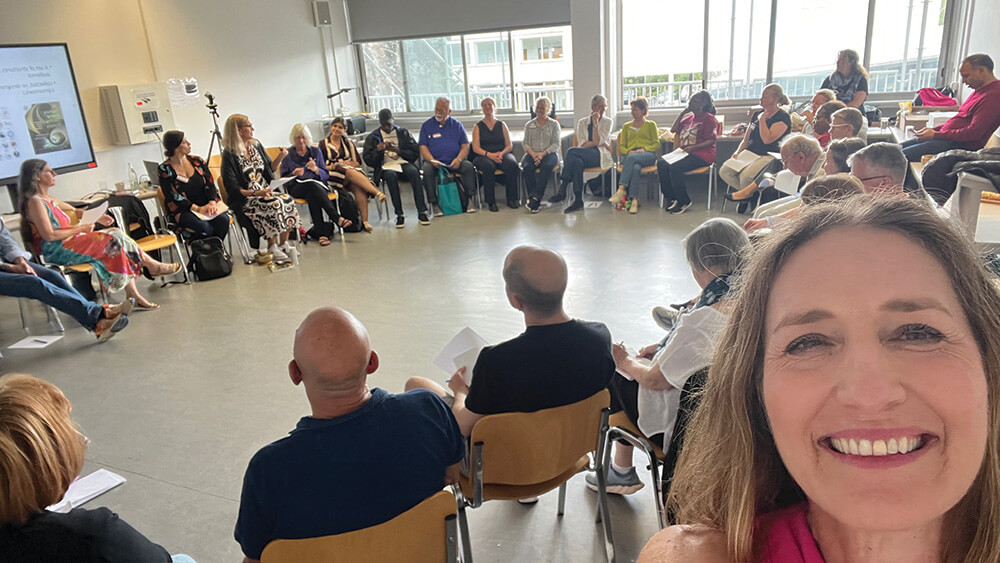“Listening is part of everybody’s job — it’s just not on people’s consciousness,” said Sandra Bodin-Lerner. Seven years ago, this public speaking coach and communications professor set out to change that, at least on New Jersey’s Kean University campus: She introduced a full semester course on listening.
“What’s really interesting — and scary — is that even within the communications world, we take for granted and assume that people can listen,” Bodin-Lerner told Convene.
It took a bit of convincing the Kean faculty that students would even want to take such a course, but it wasn’t long before it became “super popular,” she said. Each semester, students immediately recognize that they are poor listeners, how that impacts their lives, “and that everybody around them is even worse than they are. But by the end of the term, they’re really working hard at becoming better listeners,” she said. “It is just beautiful.” Many have shared the life-changing nature of the class: “Over and over again, students say, ‘This is the only course we’ve taken in four years of college that is actually applicable to real life.’”
In her professional practice, nine out of 10 clients initially consult with her for help with speaking, but “the more that I can train my clients to become better listeners, they become better speakers,” she said. “Listening is a skill. It’s not just a sense. Listening has to be intentional. You have to choose to do it. That’s a struggle because it means that you have to put aside your other basic human need to be heard yourself. We’re constantly competing to be heard first because it’s just so much more fun to talk. [We think] we’re going to be perceived as smarter or more interesting if we’re doing the talking. That’s not necessarily the case, and if we’re not listening to the other person, they can shut down.”

Structured listening activities, including listening circles, helped International Listening Convention (ILA) participants feel heard — and improved their listening skills.
Listening Circles
One of the listening activities that has fully engaged her students is the listening circle, which Bodin-Lerner learned about and has actively participated in as a board member of the International Listening Association. Although when she first heard of the concept, she said she thought, “Eh, kumbaya,” listening circles have become a highly effective and safe way for all participants to speak up and be heard, especially on divisive and potentially triggering topics like abortion.
You come to the circle “with the intention of sharing and learning, as opposed to convincing and persuading — it’s a whole different vibe,” Bodin-Lerner said. Arriving at a consensus is “not the original goal,” she said. It’s more like “let’s hear what’s out there.”
In a corporate setting, the listening circle is a great tool for brainstorming — “loudmouths” can’t monopolize the conversation and the quieter group members have the chance to speak up. “All of a sudden, you hear other points of view,” she said, “and those people have more buy-in into whatever it is that you’re talking about. It’s a great way to break up groupthink.”
Time limits can be put on how long each person speaks, “but the idea is that you should feel safe enough to not hijack the conversation because the circle continues and comes back to you another time,” Bodin-Lerner said. “What’s lovely is that sometimes you realize that what you thought you had to say right now doesn’t need to be said by the time it’s your turn again, and something else needs to be said. Now you become much more efficient about what you’re talking about because you don’t have to repeat yourself or say something that’s not really necessary, because you’ve got another chance. You don’t have to give all your ideas at once.”
Having a framework for the conversation also helps alleviate a common communication struggle. “If I’m sitting here planning my response while you’re speaking, then I’m not really listening to you,” Bodin-Lerner said. The listening circle discourages you from doing that. Instead, participants often take notes to help them process what is being said.
Keep Advice-Giving in Check
Many are surprised to learn the common practice of giving out unsolicited advice to others is a really poor listening behavior, Bodin-Lerner said — and it’s something she has struggled with the most herself.
“I used to brag about it,” she said. “As soon as you’re telling me something, I’m thinking about all these things that you should be doing. It tends to be an eye-opener for people when they learn that it’s not necessarily an empathic move, even though we do it from the heart. Unless the other person’s looking for it, you’re not doing good listening. It’s something that I’ve really had to reign in.”
But it also relieves you of the burden of having to come up with all the answers. “When you are just listening and being supportive,” she said, you help enable the other person to come up with their own solution. “I might start asking you more questions like, ‘How have you been thinking about going about this? This sounds really complicated. I know that when I’ve been through something like this, it’s been hard for me. What strategies are you using?’ Then if I really can’t control myself [laughs], I might come back and say, ‘Are you looking for some ideas?’”
Beyond using active listening to work through personal and professional issues, we should seize opportunities to leverage the practice for conflicts in our polarized society, Bodin-Lerner said. “We often don’t recognize how much we have in common with the people who we have dehumanized on the other side of the fence, due to our inability to listen to them. When we do listen in a more fulsome way to the other side,” she said, “we can discover more commonalities and humanize each other, leading to connection and conflict reduction. Rather than talking over each other, let’s talk and listen to each other.”
Michelle Russell is editor in chief of Convene.
Listen Up
This article and those listed below are part of Convene’s January/February 2024 issue cover and CMP Series story package.


